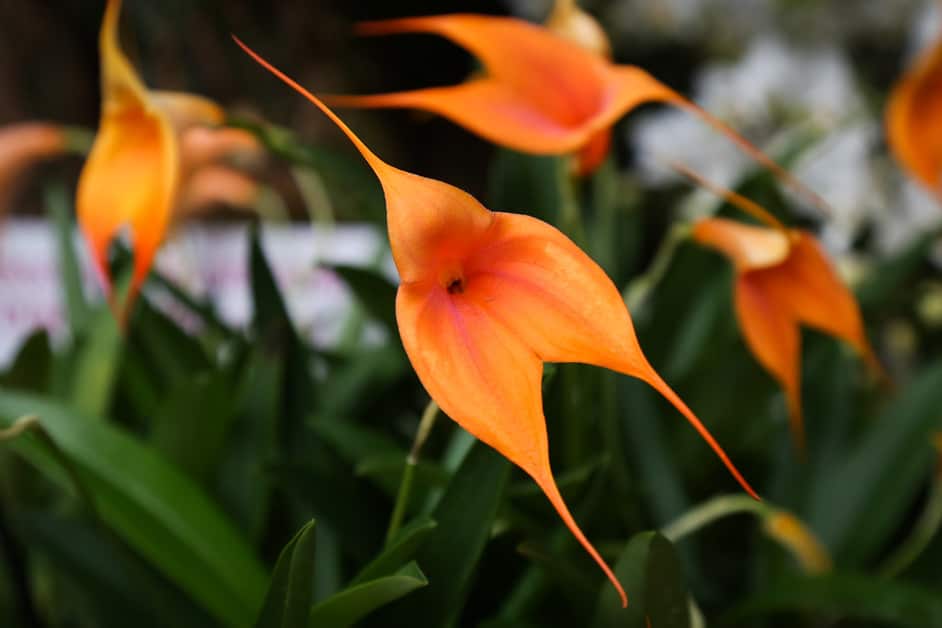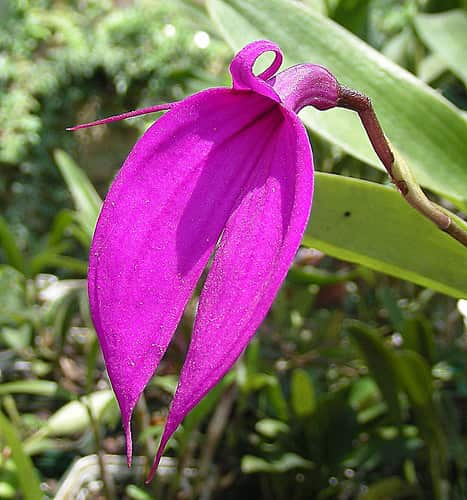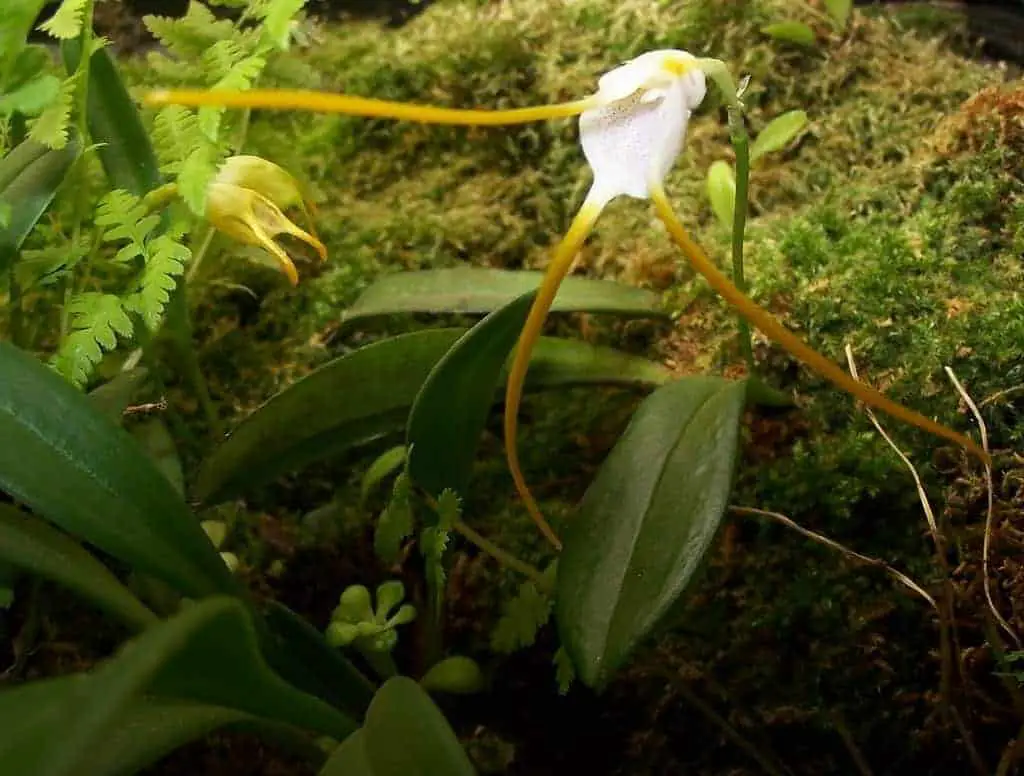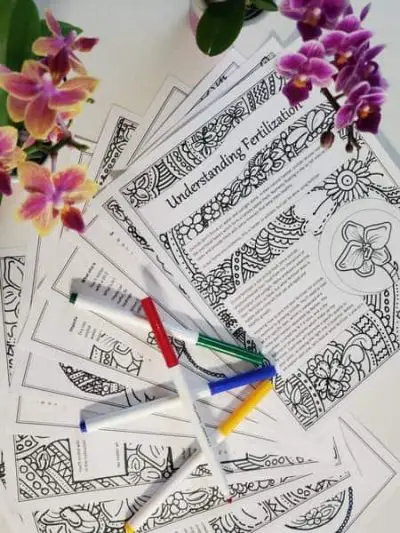Masdevallia orchids have been a surprisingly good pleasure to grow indoors with their brightly vivid and dazzling colors. I killed more than I’d like to admit before I knew how to care for them properly. In this Masdevallia care guide, I’ll show you what works for me in my home environment and how you can adapt your environment to better accommodate your Masdevallia orchids.
To properly care for a Masdevallia orchid, you need to provide a temperature of 40° to 80° F (4° to 26° C), plenty of air movement, high humidity above 70% RH, preferably in the 80-percentile range, and extremely low light (around 1,000 – 1,5000 fc). Good airflow is crucial to their growth and to the restriction of bacterial growth around their damp roots.

blumenbiene is licensed under CC BY 2.0

MASDEVALLIA IN NATURE AND NATURAL ENVIRONMENT
Masdevallias are found in nature from Mexico and Belize, growing south, down to the Guianas, Venezuela, Bolivia, and eastern Brazil. The majority of Masdevallias are found in Columbia.
Since Masdevallias are in the Pleurothallidinae tribe, they share the same or similar growing conditions with Dracula orchids. Yet unlike their closely related friends the Dracula orchids, Masdevallias are not as high up on the mountain ranges and can tolerate a little warmer climate.
They will grow in low to middle elevations in hill and montane forests, but do share the fact that they prefer shade.
Imagine you are walking along a cool, damp forest trail in the Andes. The air is exuberantly moist and cold, as water droplets drip constantly from overhead leaf petals even though it’s not raining. The smell of humid, green tree bark is overpowering and it’s pretty dark, even though it’s mid-afternoon. The darkness comes from the thick overhead growth, that completely covers and closes out the sun’s rays.
Masdevallias are found in all three growing conditions, epiphytes (on trees), lithophytes (on rocks), and terrestrial (in the ground/soil). Mostly they are epiphytes closer to the ground level.
Wet forests are the preference for Masdevallias, as they grow in clumps and clusters near the base of trees. Unlike Phalaenopsis orchids, Masdevallias don’t grow that high up on trees, preferring to thrive near mushrooms and other fungi.
In these environments, they are covered in mist all day and endure frequent, cold showers.
Even though these showers are not long-lasting, their effects are; the humidity is always high. Except you’re in the mountains, and it’s always windy so the Masdevallia roots don’t stay moist all day long.
The secret to keeping these orchids healthy is the high wind movement and air currents while providing the exceptionally high humidity requirements they desire. Of course, they don’t dry out for long either, which makes them more high maintenance than Phalaenopsis orchids.
Masdevallias are known to be grown naturally in very restricted spots, which makes them very prone to becoming extinct. In the book Orchids From Tropical America, by Joe E. Meisel, (You can see that book here  – Affiliate Link) the author states that,
– Affiliate Link) the author states that,
“Like other fly-pollinated orchids, individual Masdevallia species have very restricted ranges. The flies’ limited flight capacity isolates populations, limiting range expansion and promoting speciation. Up to 75% of all species are known only from a single collection locality. Such distribution is a recipe for extinction if the lone site is deforested.”
He goes on to mention 2 species that are already extinct the Masdevallia lychinphora and menatoi. This is a huge eye-opener for all of us orchid growers who love the hobby.
Always buy from a respected grower and include these in your collection, since they are the most colorful orchids in terms of bright, vivid colors. These are one of my favorites (yet I say that to most all the orchids I own…)

Dick Culbert is licensed under CC BY 2.0

HISTORY OF MASDEVALLIA ORCHIDS
Masdevallias are older than I was aware, first classified in 1794 by Ruiz & Pavon. These orchids were named in honor of the 18th-century Spanish physician, José Masdeval (?-1801). He served in the Spanish court of King Charles III during 1759-1788 and dabbled in amateur botany.
For an orchid this old, (better yet, for an orchid with this kind of “tradition”,) I was a tad bit disappointed that I couldn’t find more information about the story and history behind these orchids. Since that’s the case, let’s jump into the Masdevallia care guide.
MASDEVALLIA CARE GUIDE: LIGHT
Being cool-growing cloud forest orchids, Masdevallias will be covered in clouds most of their lives. They get a few rays from the sun while they nestle on tree branches or on the sides of rocky cliffs, but mostly they hardly get any direct sunlight at all.
Compared to the Phalaenopsis orchid, Masdevallias are less light tolerant. If you place these in the window where the morning sun does get them, they are very prone to sunburn.
Masdevallias prefer the lower light range, from 1,000 to 1,500 fc range, but new hybrids have been emerging to stretch that range higher up a bit. With the newer variety of warmer-growing Masdevallias, these ranges and reach up to 2,000 fc.
Just check up on your specific species to make sure what light tolerance it has.
In any case, you’ll want to keep these away from the window. Very few species of Masdevallias can actually tolerate direct sunlight.
Bright shade is what you’re aiming for, and if you use grow lights, make sure they are on the lowest setting possible.
MASDEVALLIA CARE GUIDE: TEMPERATURE
Masdevallia orchids are included in the cloud forest category, which means cool temperatures all year round. They grow best at 40° to 80° F (4° to 26° C) which is pretty cold for most indoor environments. Most sold orchids though have been crossed to tolerate warmer temperatures, and can survive in 55° to 75° F (12° to 23° C).
They are this cool because they like to grow on the side of mountain ranges and high hills, where night temperatures drop drastically.
If you live in zones 8, 9, or 10, then you could grow these orchids outdoors when the weather permits, but I have yet to test this method. I’m scared that I’ll wake up one morning and the night temperatures will have dropped too much without warning. That happens a lot in Kansas.
I’m also not a fan of dragging the orchids outside, then inside, then outside again.
MASDEVALLIA CARE GUIDE: WATERING
Being cloud forest orchids, Masdevallias thrive in high humidity environments. Even when it isn’t raining, due to the constant cloud formations near them, the humidity is extremely high.
This means that to keep them inside, you’ll have to water almost every day.
The tender roots will dry way too fast and die they dry out for extended periods of time, and by this, I mean a few hours. That’s why I keep the roots of my Masdevallia wrapped loosely in sphagnum moss, so that humidity and water will always be present.

by scott361 is licensed under CC BY-ND 2.0

MASDEVALLIA CARE GUIDE: FERTILIZER
If you add fertilized water to your other orchids, then you need to provide a new, clean source of water for your Masdevallia orchids. These do not like fertilizer and are extremely light feeders. If you use a 10-10-10, then really make that diluted but ¼. Anything stronger than that will turn the leaves yellow and they’ll fall off, due to fertilizer burn.
Also, the sphagnum moss will absorb that fertilizer more than other media and it will still be way too strong. This is one problem I face with my Masdevallia.
I have a strong hand when it comes to fertilizer and have burned more roots than I’d like to confess. So when it comes to fertilizing Masdevallia orchids, I use a separate jug of distilled water and add just a few drops of Kelp. That’s it. I only fertilize 1x a month, too.
Salt build-up is a real problem, too. This is another reason why you have to use a very light fertilizer. They say fertilize weekly, weakly, but for Masdevallias, I say fertilize “mildly, monthly”
It’s not a good idea to follow the NPK fertilizing method that is set up in this free excel spreadsheet because this method is based on the life cycle of the orchid. Masdevallias are constant bloomers (well, some at least) and don’t have a clear visual cycle of when they need to be repotted, fertilized, and are dormant.
MASDEVALLIA CARE GUIDE: POTTING MEDIA
Masdevallia orchids will prefer to be a little damp throughout the day, so in my home office, I use sphagnum moss. It’s extremely dry in here, and I have to mist them heavily every day,until I finally moved them out and into my cooler bedroom.
If you are in a climate that is more humid, then you can use very fine perlite and orchid bark, and I want to emphasize the word “fine”. Buy the smallest grade possible and sometimes, I find even that to be too big and coarse.
I found charcoal works well with these orchids too since they have to be under the use of a cool-mist evaporative humidifier, and that does tend to cause some microbial growth that I don’t like.
The charcoal will keep this ratio down to a minimum since charcoal will deplete the microorganism’s ability to reproduce and thrive in the sphagnum moss. You can read more about that in this article that I wrote about charcoal.
Clay pots have been used with success, but I haven’t tried them yet. The terracotta keeps the temperatures down and the roots cool. While I had to move all my Masdevallias out of my home office, I placed them in my bedroom right by the air conditioner vent.
Then I placed a cool-mist evaporative humidifier that blows directly on them nearby. You can check out the one that I use here (Affiliate Link) . I will try the terracotta pots…in time.
. I will try the terracotta pots…in time.
What is also currently working for me is both the net pot with sphagnum and mounted in an orchid terrarium. I’m currently writing an article on how I set that up, so as soon as it’s done. I’ll link that article here.
But just so you know, this Masdevallia terrarium has both Masdevallias and Dracula orchids in it. Their conditions are basically equal and that makes a great Masdevallia terrarium.
MASDEVALLIA CARE GUIDE: REPOTTING
As for repotting, you’ll need to repot when you see that the Masdevallias are loose in their pots. This means that the roots have died and they are in urgent need of stability to keep the plant upright.
The best time to repot is hard to evaluate since these seem to always be in bloom. Some species have specific times they bloom while most don’t. If they do, try to repot as soon as you see new roots and the blooms have all wilted, completing their normal cycle.My trick and secret here is that you should repot them as soon as you get them home from the vendor and hardly mess with them again. They aren’t the type of orchids that like to be moved or switched from location to location. Set them up and leave them alone.
MASDEVALLIA CARE GUIDE: FLOWERS & BLOOMS
The flowers on Masdevallias are pretty small, compared to other orchids like the Phalaenopsis. Masdevallias will stay within the 2 to 5 inch range (5 to 12 cm).
The good thing is that despite their size, these come in a variety of splashy, vibrant, and dazzling colors. Oranges, deep purples, bright firefighter red, and creamy yellows all make these orchids worth the struggle they are to grow.
The part of the flower that is the most vibrant is the sepal, not the petal itself. The sepals draw the pollinator’s attention (along with our own) to the center of the orchid, ready to spread pollen all over their mesmerized pollinator. The sepals elongate into a long dangling tail, making the most awesome of all shapes.
Remember the food chain from 8th-grade science class? Masdevallias are what I call an upgrade in the “pollinator chain” from Dracula orchids. Dracula orchids will attract fungus gnats and fruit flies, whereas Masdevallias will attract hummingbirds. But don’t let this fool you, because they also attract the flies, too. They can’t be picky, I guess.
The musty odor of the mushroom still remains present in most species, but some Masdevallia can be pleasantly fragrant. Personally, I don’t buy an orchid because of the fragrance, just the amazingly bright and vivid colors of the Masdevallia.
If smell is something that would be a problem, always ask your vendor if it is fragrant and specifically what fragrant it is (as in floral or decaying mushroom).
Stay away from Masdevallia nidifica (despite being one of the easiest to grow, it has a mixture of apple blossoms with decaying mushrooms, so it’s not that bad, but still…) and Masdevallia caudata (musty scent). Others aren’t so bad, but I haven’t smelled them all. Please ask your seller… Honestly, please ask.
The flowers on Masdevallias can either be erect or pendulous, depending on the species you have.
MASDEVALLIA CROSSES
Masdevallia is a huge genus with over 500 species, and growers are finding out that with the rich colors that Masdevallia contain, they are perfect sellers. It’s sad how so much of the orchid world revolves around money… Anyway, these orchids are growing in both are hearts and in the number of crosses that are available on the market.
Interesting fact: A cross from a Masdevallia and a Dracula are called Dracuvallia.
There are warm-growing Masdevallias, since growers have found that they tend to sell more than the harder to grow cool-growing Masdevallias. These warm-growing orchids are slowly growing in our hearts as they can be kept alongside all our other orchids, without all the extra apparatus. I would like to state that even though they are warm-growing, they still need tons of humidity and ample air movement.
Unlike cool-growing conditions, where bacteria don’t like the cold aspect, in a warm-growing high humidity environment, bacteria will be a huge problem. As long as you have fungicides and bactericides on hand, and conditions that eliminate these, like extremely good air movement, these warm-growing Masdevallias are perfect for your home.
The ones listed below, I found this list in the book Orchid Whisperer, by Bruce Rogers. You can buy that book here (Affiliate Link) .
.
Warm-growing Masdevallias include:
- Angel Tang,
- erinacea,
- goliath,
- infracta,
- Ken Dole,
- Maui Jewell,
- nidifica,
- pygmea,
- rex,
- Snowbird,
- tonduzii,
- tovarensis,
- and tubuliflora.
EASY-TO-GROW MASDEVALLIA ORCHIDS
Below is a list of 27 easy-to-grow Masdevallias, that don’t require such low temperatures or higher humidity ranges. Some I debated adding, but did anyway. These orchids can grow well if you keep the temperature low, but still “livable” in your home environments.
They also coincide with the more low-altitude Masdevallias, which may be the connection—higher temperatures. I made sure to add a note of the ones that aren’t low growing. For these, I’d advise to purchase only after you have successfully mastered a few of the simpler species.
These easy-to-grow Masdevallias include:
- amabilis – grows on rocks and requires more sunlight, flowers in winter
- amanda – grows better upright and on a slab,
- angulata – unpleasant smell, flowers in winter to spring
- attenuata – flowers from winter to spring,
- barlaeana – terrestrial or mossy, rocky areas, bright orange to red, flowers in spring
- bicolor – medium-sized, usually sold as a miniature
- caesia – large, deep purple flowers, usually pendulous
- caloptera – medium-sized
- caudata – medium-sized, white
- civilis – small higher altitude, single flowers in spring
- colossus – large yellowish-green, but unpleasant smell, or as some described it, a disagreeable odor.
- decumana – small purple-dotted, flowers in winter
- floribunda – small to medium, flowers in summer
- herradurae – usually sold as a miniature, flowers all year long
- hirtzii – medium-sized, flowers all year long
- infracta – called the crooked Masdevallia, blooms in summer
- instar – extremely high altitudes, flowers in spring
- lepida – light yellow to a brownish colored yellow, more difficult to grow
- mendozae – small, flowers during winter and spring
- nidifica – small, usually sold as miniatures, White to pink, commonly found for sale, easiest to grow overall
- pachyura – medium, white to yellow, usually has lots of flowers when in bloom
- peristeria – medium-sized, can be terrestrial, flowers in spring
- picea, horrible, terrible smell. Stay away at all costs. Flowers in spring.
- prodigiosa – small to medium, deep yellow to bright orange, has several growth bursts, but non-seasonal specific
- schoederiana – medium to large, white to green with purple dots, flowers during spring, may be hard to grow if the temperatures are too high
- tovarensis – medium-sized flowers, often rebloomers on the same spike, flowering in winter and often on the same old flower spike, so don’t cut the spikes
- triangularis – medium, yellow with dotted red spot, usually one flower per leaf and flowers during summer
- uniflora – medium to large, white to bright pink, species first described in 1794, small plant but extremely high altitudes. Kind of difficult, but still doable indoors
- urosalpinx – medium-sized, flowers in spring
- velifera – flowers in winter, not a very good smell. Stay away if fragrance is an issue.
- and wagneriana – usually sold as a miniature, flowers in spring.
If you are just starting out with this genus, then I’d suggest Masdevallia floribunda, infracta or nidifica. These hold up well and tolerate our mistakes until we gap the learning curve into their care.
REFERENCES AND SOURCES
Don’t stop your orchid knowledge here. Always keep researching and reading. Some interesting articles that I came across while putting together this article included:
(1) What’s in a name: Indigenous Orchids of the Andes Mountains, by Emily Conn, published in the Longwood Gardens online blog on August 11, 2021. You can read that one here .
.
(2) In this more scientific article, Nomenclatural notes in the Pleurothallidinae (Orchidaceae): miscellaneous, published in Phytotaxa in 2019 by Magnolia Press, the author explains the neotropical nomenclature of orchids in the Pleurothallidinae and how they are classified. These include the Masdevallia and Dracula orchids, along with others like Acianthera, Dilomilis, Dracula, Masdevallia, Octomeria, Pabstiella, Restrepiella, Specklinia, and Stelis. You can read that article here .
.
Don’t Stop Learning!
If you want to be included in more information and get a 14-page fertilization guide, please sign up for my newsletter. I don’t spam, but send emails out bi-monthly with some curious topics of interest. If you want more information, click here to go to a specific page on this website where I explain it more in detail.

Also, if you are looking for an orchid journal to keep your notes specifically about orchid care, check out my 2 solutions for that on this page. If note-keeping isn’t your thing, then there is a free excel spreadsheet that you can download. Click here for more information on how to do that.
If you subscribe to my newsletter, I will send you a 14-page guide on the main tips of orchid fertilizer. It is downloadable and you can print it out on your computer. I designed the guide to double up as a coloring book, just to make it fun.
In all, I wish you the best in your orchid care.
Happy Cultivating!


only a few survived.